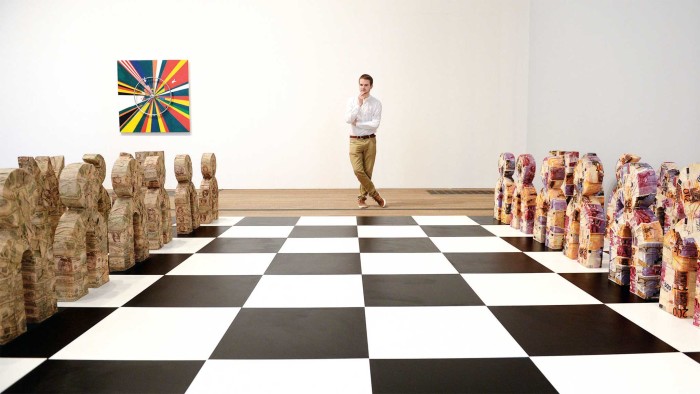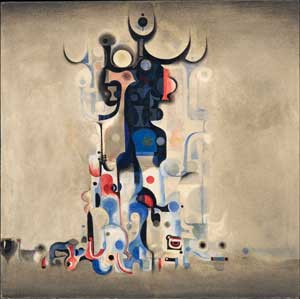Africa’s bright glare

Simply sign up to the Life & Arts myFT Digest -- delivered directly to your inbox.
Name an African artist. Name two more. It’s a struggle: African art still has the most minor presence in the world’s museums, biennales, galleries. And when we do see it, too often it lacks the context for us to make sense of it.
Tate Modern’s double show of Sudan-born Ibrahim el-Salahi, who lives in Oxford, and Meschac Gaba, based between Benin and the Netherlands, acknowledges this. An exhibition of muted, introverted visionary painting is set against a loud, bright deconstruction of social currency – the same contrast, as it happens, that Tate Britain negotiates in its summer shows devoted to L.S. Lowry versus Patrick Caulfield.
But while Millbank luxuriates in familiar-name blockbusters, Bankside sets out to break preconceptions and clichés, for the first time according two Africans the large-scale singular exhibitions customarily devoted to western artists.
In the 1960s el-Salahi was shown at New York’s Museum of Modern Art alongside Picasso and Mark Rothko but he is unfamiliar on today’s art circuit. In the 1970s he worked as a cultural administrator in Khartoum, painted little and was thrown into jail on false allegations of anti-government activity. On his release, he moved to Qatar, then England. He is a devout Muslim, praying five times a day and before he paints. Now in his eighties, he continues to work, particularly on a series, “The Tree”, where lines of coloured ink dissolve in pools on watercolour paper – limpid, delicate, ever-changing downward-pulsing patterns provoked by the view from his Oxfordshire window but inspired more deeply by memories of the haraz tree in Sudan’s Nile valley.
During the rainy season and the flooding of the Nile, el-Salahi says, the haraz “is completely dry, with dry leaves, nothing at all. Then during the drought it comes out with blooms and with fruit and everything. This is a definitive statement. Like saying, I am me! I am an individual! I do not follow what everyone is doing.”
The “Tree” series has the simplification, abstraction, even detachment from the world characteristic of late style. It is also rare, at least among works I have encountered from the African continent, in moving beyond issues of cultural identity to pure personal expression. But then, as Tate shows in this thoughtful retrospective, el-Salahi’s experiments with figuration carried from the start an emotional turbulence channelled into an abstracting rigour. A tone of elegant mournfulness dominates everywhere.
Tate has just acquired el-Salahi’s signature piece, “Reborn Sounds of Childhood Dreams” (1961-65): a depiction in enamel and oil paint on cloth of full frontal black/grey mask-headed, half-abstracted figures composed of elementary forms – including the crescent moon of Islam, recurring throughout el-Salahi’s oeuvre – and calligraphic lines. Inevitably, ambitiously, their pose, linearity, position on a flat ground and the almost square format call to mind formal attributes of Picasso’s “Les Demoiselles”.
A fusion of African imagery and Arabic ornamentation with western modernism is the impetus of the 1960s works that made el-Salahi’s name internationally. He studied at the Slade but the discovery that made most impact on him in London was the manuscripts at the British Museum. “I found that each curve in a human or animal form immediately evoked in my mind the curve of a letter,” he says.
In “They Always Appear” (1966-68), dark imaginary beings are woven out of an abstraction of Arab script broken down to its basic elements and reformed. In “Funeral and the Crescent”, these masked figures become skeletal, elongated mourners, barely more embodied than the corpse they carry towards the viewer; they allude to the outpouring of grief following the assassination of Congo prime minister Patrice Lumumba. “Self-Portrait of Suffering” (1961) represents the artist as a skull: an abbreviated line drawing in oil recalling the self-portraits in old age that Picasso was making at this time.
Although Munch and Giacometti also come to mind at various points here, these works never feel western – chiefly, I think, because they are infused with the relentlessly bright Sudanese light, earthy colour and a palpable sense of a parched landscape and dry hot air: the enamel and titanium white powdery “Dry Months of the Fast”, in which moon and bird forms seem burnt into the Masonite surface; the warm, baked ground from which half-perceived shapes and colours emerge in “Vision of the Tomb” and “No Shade but His Shade”.
“In the Sudan there is such glare that you have to half-close your eyes,” el-Salahi says, “so your impressions are almost half-seen, but I feel them through another eye; I know it by experience of another kind.”

To leave el-Salahi’s meditative visions for the dozen busy rooms, resounding to African music, comprising Meschac Gaba’s “Museum of Contemporary African Art” (1997-2002), is to go from a hard-fought expression of interiority of being – modernism’s core tenet – to the aggressive conceptual premise that art and everyday life are indistinguishable. Gaba’s installations include a working “Museum Shop”; an “Art and Religion” room, decked out with candles, crucifixes, Islamic prayer mat and Jewish prayer shawl, kitsch sculptures of the Madonna and a Hindu goddess, and a (much-in-demand) Tarot-card reader; a “Salon” where visitors can play a grand piano filled with chocolate coins and an Adji computer game adapted from the traditional African game Awele; and a “Marriage Room”, with videos, photographs, bridal gown, presents and marriage certificate. This last records the performance piece at the exhibition For Real at Amsterdam’s Stedelijk Museum in which Gaba wed curator Alexandra van Dongen, witnessed by the couple’s mothers, invited guests, and museum-goers who happened to drop into the Stedelijk on October 6 2000.
“My museum doesn’t exist. It’s only a question,” Gaba says of this complex, sprawling work, which Tate has just bought through its Acquisitions Fund for African Art. It is a very Tate piece: playful, political, participatory, trading in motifs of globalisation and the postcolonial reality, but museological too in its reappraisal of the relationship between viewer, art object, artist.
It sometimes amuses, bemuses, but is mostly over-obvious: a tree of fabricated banknotes featuring Picasso as president of Ghana and Brâncusi as a general with a white beard – both artists appropriated African art; jigsaw puzzles asking visitors to reconfigure the flags of Algeria, Angola, Chad, Morocco, Senegal, the Seychelles, to suggest the “complexity of building autonomous nations” and reconstituting democracy.
Tate calls Gaba’s “Museum” “a provocation to the western art establishment …to attend to contemporary African art”. With these two shows, it begins to answer that difficult challenge; only time will tell, however, whether Gaba’s piece is a conceptual landmark, an extended joke or a politically correct, already rather dated, 1990s installation.
——————————————-
‘Ibrahim el-Salahi: A Visionary Modernist’ and ‘Meschac Gaba: Museum of Contemporary African Art’, Tate Modern, to September 22 www.tate.org.uk
Comments